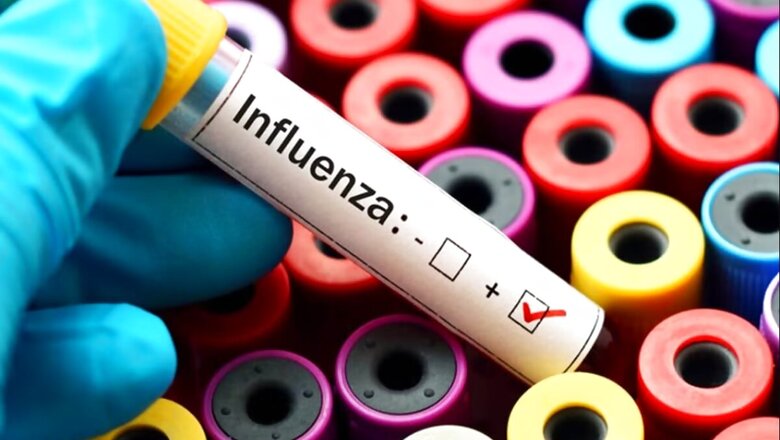
views
The Union Health Ministry on Friday said the Influenza A subtype H3N2 is being strictly monitored and cases are expected to decline by March-end. The statement came hours after India recorded its first two deaths due to the virus infection, one each from Karnataka and Haryana.
According to the government, seasonal influenza is a respiratory illness caused by influenza viruses that are prevalent across the globe, with cases typically increasing during certain months. “India every year witnesses two peaks of seasonal influenza: one from Jan to March and other in post monsoon season. The cases arising from seasonal influenza are expected to decline from March end,” an official statement read, adding State’s surveillance officers are fully equipped to tackle this public health concern.
NITI Aayog will hold an inter-ministerial meeting on Saturday to evaluate the status of seasonal influenza in States and identify methods to provide additional assistance in terms of public health measures, management guidelines, and protocols for handling the rising number of cases.
Real time surveillance
The Union Health Ministry is keeping a close watch on the Seasonal Influenza situation in various States/UTs through the Integrated Disease Surveillance Programme (IDSP) network on a real-time basis, the release read.
Near real-time surveillance of cases of Influenza Like Illness (ILI) and Severe Acute Respiratory Infections (SARI) in OPDs and IPDs of health facilities are undertaken by the Integrated Disease Surveillance Programme (IDSP), National Centre for Disease Control (NCDC).
The ministry is actively monitoring the incidence of illness and death caused by the H3N2 virus and has noted children and elderly age groups with pre-existing medical conditions are most vulnerable to seasonal influenza.
Total Cases
According to the latest data available on IDSP – IHIP-Integrated Health Information Platform, a total of 3,038 laboratory-confirmed cases of various subtypes of Influenza, including H3N2, have been reported till March 9 by the States. This includes 1,245 cases in January, 1,307 in February and 486 cases in March (till March 9).
Data from health facilities indicate that during the month of January, a total of 3,97,814 cases of Acute Respiratory Illness/Influenza Like Illness (ARI/ILI) were reported from the country, which increased slightly to 4,36,523 during February. In the first 9 days of March, this number stands at 1,33,412 cases.
For admitted cases of severe acute respiratory illness (SARI), 7,041 cases were registered in January, 6,919 during February and 1,866 till March 9.
The government has reported a total of 955 cases Novel influenza A (H1N1) virus infections, also called as swine flu till February 28. Majority of the H1N1 cases are reported from Tamil Nadu (545), Maharashtra (170), Gujarat (74), Kerala (42) and Punjab (28).
As of now, Karnataka and Haryana have reported one fatality each due to H3N2 influenza. In Karnataka, 82-year-old Hire Gowda died due to the H3N2 virus on March 1. According to a PTI report, a 56-year-old male resident of Jind district died on February 8 at home and was a lung cancer patient. “He had tested positive for H3N2 virus in January at PGIMS hospital in Rohtak,” officials said.
Public Health Measures
The Health Ministry has provided guidelines on the categorisation of patients, treatment protocol, and guidelines on Ventilatory management to the States/UTs in its guidelines on seasonal influenza. The has also advised the state governments for vaccination of healthcare workers dealing with H1N1 cases.
The ministry has noted that seasonal influenza subtype H3N2 is the major cause of current respiratory illness.
Here’s what the government has said:
- Pan respiratory virus surveillance has been established by ICMR/DHR across 30 VRLSs.
- Surveillance data from 15th December till date reflected the rise in number of cases of Influenza A H3N2
- About half of all inpatient severe acute respiratory infections (SARI) and outpatient influenza like illness were found to have Influenca A H3N2.
Clinical features of Influenza A H3N2:
- This subtype appears to cause more hospitalisations than other influenza subtypes.
- Of hospitalised SARI patients with influenza A H3N2, about 92% presented with fever, 86% with cough, 27% with breathlessness, 16% with wheezing. Additionally, 16% had clinical signs of pneumonia and 6% had seizures.
- 10% of SARI patients who have H3N2 needed oxygen and 7% required ICU care.
Drugs and Logistics
The World Health Organization (WHO) has recommended the drug Oseltamivir for treatment and it is made available through the Public Health System free of cost. Government has allowed sale of Oseltamivir under Schedule H1 of the Drug and Cosmetic Act in February 2017 for wider accessibility and availability.
Adequate logistics is available with the States, the Centre has said. However, in case of any emergencies, the Government of India has been providing support to the States to tide over the crisis, it added.
Read all the Latest India News here

















Comments
0 comment